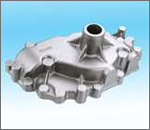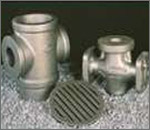Gray iron’s high damping capacity, combined with its excellent machinability and high hardness, is unique to this material and makes it ideally suited for machine bases and supports,

engine cylinder blocks and brake components. Excessive vibration causes inaccuracies in precision machinery and excessive wear on gear teeth and bearings. The damping capacity of gray iron is considerably greater than that of steel and other iron types.
For example, if gray iron, CGI and ductile iron have a similar composition, the relative damping capacity of gray iron is 1.0, CGI is 0.35 and ductile iron is 0.14. The damping capacity of gray iron is about 20-25 times higher than steel. For comparison, aluminum’s damping capacity is one-tenth that of steel.
The graphite flakes in gray iron have less influence on its compression properties than on tension properties.
Gray iron's compressive strength is typically three to four times more than its tensile strength. The lack of graphite-associated volume changes allows for a similar Poisson’s ratio to other engineering metals but different tension properties. Poisson’s ratio remains constant at 0.25 over a large compressive stress range and increases at higher stress levels.

To classify gray iron in accordance to its tensile strength, ASTM Standard A48 and Society of Automotive Engineers (SAE) Standard J431 provide the best details. The two specifications approach the task from different standpoints, but the concept essentially remains the same. For example, the number in a Class 30 gray iron refers to the minimum tensile strength in ksi. In ASTM A48,a standard size test bar is added to the class. Class 30A indicates that the iron must have a minimum 30 ksi (207 MPa) tensile strength in an “A” bar (0.875-in. as-cast diameter).
In SAE Standard J431, tensile strength is not required, but hardness and a minimum tensile strength to hardness ratio are required. The class then is identified as a grade. A Class 30B iron for ASTM A48 would be comparable to a grade G3000 in SAE Standard J431. The other gray iron specifications build off of these two primary specifications.


